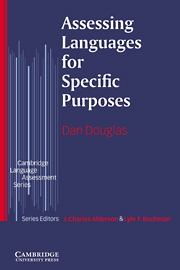Book contents
- Frontmatter
- Contents
- Series editors' preface
- Acknowledgements
- 1 Why test language for specific purposes?
- 2 Specific purpose language ability
- 3 Context, discourse domains, and task characteristics
- 4 Strategic competence: between knowledge and context
- 5 From target language use to test tasks
- 6 Specific purpose tests of listening and speaking
- 7 Specific purpose tests of reading and writing
- 8 LSP test development and technology
- Appendix: other LSP tests
- References
- Index
7 - Specific purpose tests of reading and writing
Published online by Cambridge University Press: 03 May 2010
- Frontmatter
- Contents
- Series editors' preface
- Acknowledgements
- 1 Why test language for specific purposes?
- 2 Specific purpose language ability
- 3 Context, discourse domains, and task characteristics
- 4 Strategic competence: between knowledge and context
- 5 From target language use to test tasks
- 6 Specific purpose tests of listening and speaking
- 7 Specific purpose tests of reading and writing
- 8 LSP test development and technology
- Appendix: other LSP tests
- References
- Index
Summary
Introduction
In this chapter we will examine a number of specific purpose tests of reading and/or writing. As in Chapter 6, the purpose here is to explore the various approaches LSP test developers have taken to test language for specific purposes. We will consider the same three categories of tests as we looked at in Chapter 6: those for purposes of admission to academic or training programs, those for certification as teachers, and those for other vocational and professional purposes. The first test we will consider, the Oxford International Business English Certificate (OIBEQ), will be analyzed at the same level of detail as the OET in Chapter 6. The OIBEC displays a high level of situational and interactional authenticity and is an example of good LSP testing practice.
Sample analysis of test task characteristics: Oxford International Business English Certificate: writing task
The OIBEC, developed by the University of Oxford Delegacy of Local Examinations, is aimed at business men and women working in international commerce who wish to obtain a certificate of competence in English language skills for purposes of promotion or changing employment (University of Oxford Delegacy of Local Examinations 1990). The test is given at two levels: First Level, a basic qualification, and Executive Level, an advanced qualification. Available in some 44 countries world-wide, the test takes about two and a quarter hours, comprising a 20-minute listening component, a 20-minute speaking component, and a one hour and 35-minute reading and writing component. A significant feature of the OIBEC is a case study booklet, which provides extensive information about a problem that forms the context of the test.
Information
- Type
- Chapter
- Information
- Assessing Languages for Specific Purposes , pp. 189 - 245Publisher: Cambridge University PressPrint publication year: 1999
